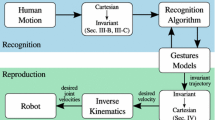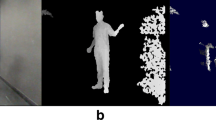Abstract
Recognizing and reproducing spatiotemporal motions are necessary when analyzing behaviors and movements during human-robot interaction. Rigid body motion trajectories are proven as compact and informative clues in characterizing motions. A flexible dual square-root function (DSRF) descriptor for representing rigid body motion trajectories, which can offer robustness in the description over raw data, was proposed in our previous study. However, this study focuses on exploring the application of the DSRF descriptor for effective backward motion reproduction and motion recognition. Specifically, two DSRF-based reproduction methods are initially proposed, including the recursive reconstruction and online optimization. New trajectories with novel situations and contextual information can be reproduced from a single demonstration while preserving the similarities with the original demonstration. Furthermore, motion recognition based on DSRF descriptor can be achieved by employing a template matching method. Finally, the experimental results demonstrate the effectiveness of the proposed method for rigid body motion reproduction and recognition.
摘要
在人机交互中, 时空运动的识别和复现是分析人体行为和运动必要的前提条件。刚体运动轨 迹被证明可以为运动描述提供充分信息线索。在之前的研究中, 我们提出了一种灵活的双平方根函 数轨迹描述(DSRF)来表示刚体运动轨迹, 它相对于原始数据提供鲁棒的描述。本研究的重点是探 索DSRF描述子在有效的运动复现和运动识别中的应用。具体而言, 本文提出了两种基于DSRF的 复现方法, 包括递归重构和在线优化。具有上下文信息的新轨迹可以从单个示教轨迹复现, 同时保 留与原始轨迹的相似性。此外, 采用模板匹配方法实现了基于DSRF描述子的运动识别。实验结果 验证了该方法对刚体运动的再现和识别的有效性
Similar content being viewed by others
References
ZHANG H B, ZHANG Y X, ZHONG B N, et al. A comprehensive survey of vision-based human action recognition methods [J]. Sensors, 2019, 19(5): 1005.
KONG Y, FU Y. Human action recognition and prediction: A survey [J]. International Journal of Computer Vision, 2022, 130(5): 1366–1401.
GUO Y, LI Y F, SHAO Z P. RRV: A spatiotemporal descriptor for rigid body motion recognition [J]. IEEE Transactions on Cybernetics, 2018, 48(5): 1513–1525.
WU S D, LI Y F. Motion trajectory reproduction from generalized signature description [J]. Pattern Recognition, 2010, 43(1): 204–221.
VUKOVIĆ N, MITIĆ M, MILJKOVIĆ Z. Trajectory learning and reproduction for differential drive mobile robots based on GMM/HMM and dynamic time warping using learning from demonstration framework [J]. Engineering Applications of Artificial Intelligence, 2015, 45: 388–404.
PARK H S, SHIRATORI T, MATTHEWS I, et al. 3D trajectory reconstruction under perspective projection [J]. International Journal of Computer Vision, 2015, 115(2): 115–135.
GUO Y, LI Y F, SHAO Z P. DSRF: A flexible trajectory descriptor for articulated human action recognition [J]. Pattern Recognition, 2018, 76: 137–148.
CALINON S, D’HALLUIN F, SAUSER E L, et al. Learning and reproduction of gestures by imitation [J]. IEEE Robotics & Automation Magazine, 2010, 17(2): 44–54.
GARRIDO J, YU W, LI X O. Robot trajectory generation using modified hidden Markov model and Lloyd’s algorithm in joint space [J]. Engineering Applications of Artificial Intelligence, 2016, 53: 32–40.
PARASCHOS A, NEUMANN G, PETERS J. A probabilistic approach to robot trajectory generation [C]//2013 13th IEEE-RAS International Conference on Humanoid Robots (Humanoids). Atlanta: IEEE, 2013: 477–483.
KHANSARI-ZADEH S M, BILLARD A. Learning stable nonlinear dynamical systems with Gaussian mixture models [J]. IEEE Transactions on Robotics, 2011, 27(5): 943–957.
VOCHTEN M, DE LAET T, DE SCHUTTER J. Comparison of rigid body motion trajectory descriptors for motion representation and recognition [C]//2015 IEEE International Conference on Robotics and Automation. Seattle: IEEE, 2015: 3010–3017.
DE SCHUTTER J. Invariant description of rigid body motion trajectories [J]. Journal of Mechanisms and Robotics, 2010, 2(1): 1.
VOCHTEN M, DE LAET T, DE SCHUTTER J. Generalizing demonstrated motions and adaptive motion generation using an invariant rigid body trajectory representation [C]//2016 IEEE International Conference on Robotics and Automation. Stockholm: IEEE, 2016: 234–241.
GUO Y, LI Y F, SHAO Z P. DSRF: A flexible descriptor for effective rigid body motion trajectory recognition [C]//2016 IEEE International Conference on Mechatronics and Automation. Harbin: IEEE, 2016: 1673–1678.
DIEBEL J. Representing attitude: Euler angles, unit quaternions, and rotation vectors [J]. Matrix, 2006, 58(15/16): 1–35.
SRIVASTAVA A, KLASSEN E, JOSHI S H, et al. Shape analysis of elastic curves in Euclidean spaces [J]. IEEE Transactions on Pattern Analysis and Machine Intelligence, 2011, 33(7): 1415–1428.
KADOUS M W. Temporal classification: Extending the classification paradigm to multivariate time series [D]. Kensington: University of New South Wales, 2002.
Author information
Authors and Affiliations
Corresponding author
Additional information
Foundation item: the Science and Technology Commission of Shanghai Municipality (No. 20DZ2220400), and the Interdisciplinary Program of Shanghai Jiao Tong University (No. YG2021QN117)
Rights and permissions
About this article
Cite this article
Yang, J., Guo, Y. On Flexible Trajectory Description for Effective Rigid Body Motion Reproduction and Recognition. J. Shanghai Jiaotong Univ. (Sci.) 28, 339–347 (2023). https://doi.org/10.1007/s12204-023-2604-0
Received:
Accepted:
Published:
Issue Date:
DOI: https://doi.org/10.1007/s12204-023-2604-0
Key words
- human-robot interaction
- rigid body motion trajectory
- trajectory description
- motion reproduction and recognition




